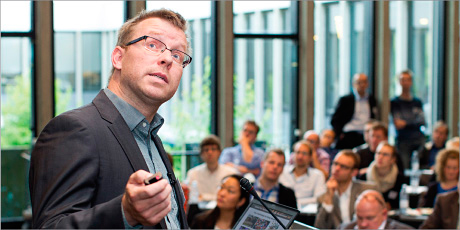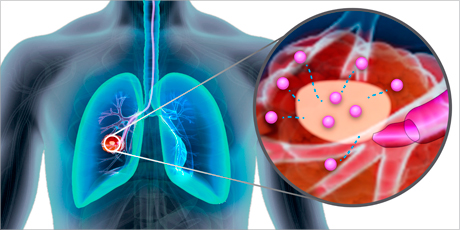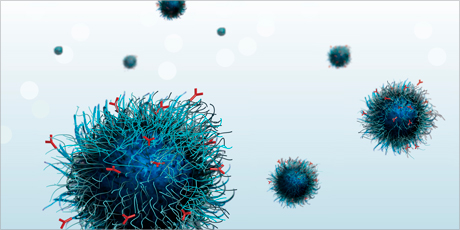The DTU Center for Nanomedicine and Theranostics develops advanced biomaterial technology and new medical inventions for diagnosing and treating severe diseases. The strong multidisciplinarity of the center allows for research in new biomedical technologies and evaluation of new treatment concepts in vitro and in vivo.
In January 2012 the center was established at the Technical University of Denmark as a joint strategic research programme between the Department of Chemistry and the Department of Micro- and Nanotechnology. Additionally, DTU Vet and DTU Nutech joined the programme as partners in September 2012.

Professor Thomas L. Andresen at the center inauguration (photo by Jesper Scheel)
The aim of the center
The center focuses on new technologies for personalized treatment of diseases where therapeutic benefits for the individual patient can be evaluated before and during treatment, i.e. integration of therapy and diagnostics, a concept known as theranostics.
This way a patient will only receive treatment for as long as there is a positive therapeutic response. And since time is not wasted on ineffective therapeutic regimes, the patient should have a better chance for overall treatment success, side effects are reduced, and finally treatment is more cost effective for society.

Figure 1: Nanoparticles crossing cellular barrier in a lung tumor (graphic design by Nanna Bild)
Nanomedicine provides many new possibilities for developing personalized treatment modalities, e.g. for fast in vitro diagnostics and disease staging during treatment as well as for in vivo diagnostics and advanced imaging protocols that can be combined with nanomedicine based therapeutics.
From general to individual cancer treatment
Today, treatment of patients with a given disease is suffering from “averaging effects”, i.e. a patient’s disease is assessed or staged, and treatment is given based on the best protocol for the “average” patient on this specific stage.
For diseases such as cancer, the benefits of the treatment are often not evaluated until several months after the initiation of the treatment. For the patients, who do not respond positively to the chosen treatment protocol, valuable time is wasted, time that could have been spent trying out alternative types of therapy. Such a prolongation of treatment could have fatal consequences.
What if it was possible to detect the effect of a given treatment for the individual patient during treatment?
Will an early change to a different treatment regime save lives for non-responders? The answer is most likely, yes! Furthermore, the patient will be spared unnecessary side effects and our health system will save the costs associated with ineffective treatments.
To achieve this, we need to rethink drug and treatment regime development, and implement tools for early testing of treatment effect as part of the new therapeutic development.
The DTU Center for Nanomedicine and Theranostics is developing new technologies for diagnosing, staging and treating disease. This includes development of new therapeutics where drug delivery systems are of particular interest and on developing new in vivo imaging tools. The center integrates therapy and diagnostics to bring forward new innovative solutions in personalized medicine.
Improvement of fundamental knowledge on biological interactions
The ability to control transport and delivery of molecules in organisms and cells is one of the most essential parameters in biomedical research. Transport across biological barriers is particularly important and this has led to intensive research in delivery systems where nanocarriers are a prime example.

Figure 2: Nanocarriers (graphic design by Nanna Bild)
However, our ability to design and engineer drug delivery systems is insufficient and further progression requires basic research at the interface of multiple scientific disciplines. Accordingly, the Center for Nanomedicine and Theranostics aims to enhance the fundamental knowledge of biological interactions and transport mechanisms of drug delivery systems on single-molecule level.
Nanomedicine and nanoparticles
A major part of the center’s activities are focused within the field of nanomedicine. Nanoparticle systems are engineered for multiple applications, e.g. nanocarriers of drugs for treating cancer and inflammatory diseases, as well as positron emission tomography (PET), computed tomography (CT) and magnetic resonance (MR) imaging agents.
The center’s core expertise includes synthesis of new molecular entities and biomaterial engineering on nanoscale, biophysical chemistry and elucidation of molecular interactions, investigations of drug delivery systems and biomaterials in a biological setting.
Viruses as a role model
Viruses, one of nature’s optimized nanocarrier systems, are capable of selectively seeking out specific cells in higher organisms and penetrating the protective cellular barriers effectively.

Figure 3: Virus (graphic design by Nanna Bild)
The center’s vision is to develop drug delivery and diagnostics systems that can target specific cells and cross cell barriers in the same selective manner as viruses, i.e. copy the way that a virus interacts with cells, and is transported across barriers inside the body. Through such work researchers will gain a better understanding of the molecular interactions of these systems at the protein, organelle and cellular levels.
The center will create new possibilities in drug delivery and biomedical research and aid the development of future generations of medicine that are far more specific than what we can achieve today.
A change in research methodology
Development in this area has in the past been hampered by an obstinate focus on biological performance and a gap between material scientists and biologists with regard to research approach and methodology. The result is inadequate focus on the individual molecular mechanisms that in combination dictate biological behavior, and a poor understanding of how fundamental material properties influence biological interactions.
Future development of biomedical technology depends on a change in research methodology – from an empirical to a hypothetico-deductive approach, and The Center for Nanomedicine and Theranostics’ research philosophy, motivation and organization is sparked by this change.